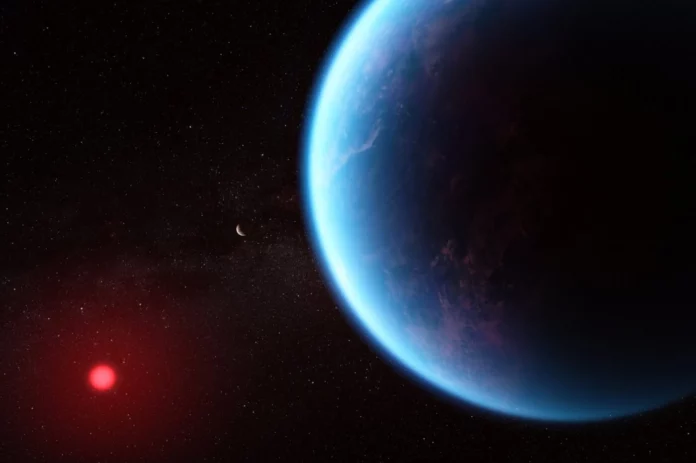The James Webb Space Telescope (JWST) may have detected signs of a potential biosignature on a steamy, ocean-covered exoplanet called K2-18b – a biosignature that marine life on Earth produces.
The protagonist here is dimethyl sulfide, a molecule produced by many ocean life, but especially plankton. If this molecule is indeed floating around in the atmosphere of K2-18b, it raises the tantalizing possibility that something on the planet might be alive. Or at least emitting suspiciously life-like chemical signals.
K2-18b, located 120 light-years away, has been on scientists’ radar since NASA‘s Kepler space telescope spotted it in 2015. It is about 8.6 times the mass of the Earth and orbits within the habitable (or “golden”) zone of a red dwarf star.
Previous Hubble observations had hinted that K2-18b had water vapor in its atmosphere, but this was later found to be false. But JWST has gone a few more steps forward by doubling down on the previous discovery of dimethyl sulfide in the planet’s atmosphere. The team that made this discovery, led by Nikku Madhusudhan of the University of Cambridge, consists of researchers from five institutions.
This discovery indicates that K2-18b may indeed be a Hyacinthian world, or a water-covered planet with a hydrogen-rich atmosphere. But the team’s observations, made with the JWST Mid-Infrared Imaging Survey Instrument (MIRI) and previous NIRISS and NIRSpec data, revealed methane and carbon dioxide on the planet, but very little ammonia.
This interesting mixture suggests that K2-18b contains an aqueous, potentially habitable environment. Importantly, the team also found more evidence for the presence of dimethyl sulfide, as well as a related molecule, dimethyl disulfide. The team’s work replicates the 2023 discovery and adds even more confidence to the possibility of life on a relatively close exoplanet – provided that the findings are valid and that dimethyl sulfide is produced and behaves on exoplanets in the same way as on Earth. The team’s findings are published in the journal The Astrophysical Journal Letters.
Speaking to the BBC, Madhusudhan said that his team discovered a surprising amount of gas in a single observation. “We estimate that the amount of this gas in the atmosphere is thousands of times greater than on Earth,” he explained, adding that if the link to life is credible, “then this planet will be teeming with life.” And if scientists confirm the presence of life on K2-18b, “it would essentially confirm that life is very common in the galaxy,” Madhusudhan said in an interview with the British Broadcasting Corporation.

In its landmark decadal review of astronomy and astrophysics, the National Academies made one thing clear: the search for habitable worlds should be a top scientific priority. The James Webb Space Telescope is central to this mission, and while NASA already has plans for its eventual successor, the Habitable Worlds Observatory, this next-generation telescope will not be launched for at least another decade. Until then, Webb and the ever-reliable Hubble will carry the baton in our search for life beyond Earth.
The detection is not yet a done deal – it has a statistical confidence of about 3 sigma (about 99.73%), which makes it interesting but not conclusive. A detection at the 5 sigma level (about 99.99994% confidence) is usually the gold standard for confirming a discovery. And even at the 5 sigma level, it only confirms the presence of dimethyl sulfide in the planet’s atmosphere, not that dimethyl sulfide is of biotic origin. There is still a possibility that abiotic (non-biotic) processes or instrumental tricks could be the cause. Last Sunday, a separate team published a paper on the arXiv preprint server suggesting that the planet may not be an ocean at all, but a rocky world covered in magma, with a hydrogen-rich sky – and virtually no chance of life.
Further observations will help confirm the team’s findings. But if life does exist on K2-18b, the evidence suggests that it is likely microbial, rather than a sign of alien intelligence. It is important to note that microbial life-like plankton existed on Earth for a billion years, a long but crucial stage that paved the way for the emergence of more complex organisms. Despite this, life has never been found outside of Earth, so confirming the existence of even a single amoeba on a distant world would be nothing short of a revelation.
At the very least, K2-18b is becoming one of the most promising places to search for life beyond Earth. And at most, if further research confirms the recent findings, we may get the first chemical signs of a living ocean on another world.









